Canon FS40, FS400 Instruction Manual

PUB. DIE-0380-000
Digital Camcorder
Instruction Manual

 COPY
COPY

Important Usage Instructions
WARNING!
TO REDUCE THE RISK OF FIRE OR ELECTRIC SHOCK, DO NOT EXPOSE THIS PRODUCT TO RAIN OR MOISTURE.
WARNING!
TO REDUCE THE RISK OF ELECTRIC SHOCK AND TO REDUCE ANNOYING INTERFERENCE, USE THE RECOMMENDED ACCESSORIES ONLY.
COPYRIGHT WARNING:
Unauthorized recording of copyrighted materials may infringe on the rights of copyright owners and be contrary to copyright laws.
Digital Video Camcorder FS40 A / FS400 A systems
This device complies with Part 15 of the FCC Rules. Operation is subject to the following two conditions: (1) This device may not cause harmful interference, and (2) this device must accept any interference received, including interferenceCOPYthat may cause undesired operation.
Note: This equipment has been tested and found to comply with the limits for class B digital device, pursuant to Part 15 of the FCC Rules. These limits are designed to provide reasonable protection against harmful interference in a residential installation. This equipment generates, uses and can radiate radio frequency energy and, if not installed and use in accordance with the instructions, may cause harmful interference to radio communications. However, there is no guarantee that interference will not occur in a particular installation. If this equipment does cause harmful interference to radio or television reception, which can be determined by turning the equipment off and on, the user is encouraged to try to correct the interference by one or more of the following measures:
•Reorient or relocate the receiving antenna.
•Increase the separation between the equipment and receiver.
•Connect the equipment into an outlet on a circuit different from that to which the receiver is connected.
•Consult the dealer or an experienced radio/TV technician for help.
Use of shielded cable is required to comply with class B limits in Subpart B of Part 15 of FCC Rules. Do not make any changes or modifications to the equipment unless otherwise specified in the manual. If such changes or modifications should be made, you could be required to stop operation of the equipment.
Canon U.S.A., Inc.
One Canon Plaza, Lake Success, NY 11042, U.S.A.
Tel No. (516)328-5600
CAUTION:
TO PREVENT ELECTRIC SHOCK, MATCH WIDE BLADE OF PLUG TO WIDE SLOT, FULLY INSERT.
2

WARNING:
To reduce the risk of electric shock, do not expose this product to dripping or splashing.
The Mains plug is used as the disconnect device. The Mains plug shall remain readily operable to disconnect the plug in case of an accident.
CAUTION:
•Danger of explosion if the wrong type of batteries are attached. Use only the same type of batteries.
•Do not expose batteries or product to excessive heat such as the inside of a car under direct sunlight, fire, etc.
Important Warning
CAUTION
RISK OF ELECTRIC SHOCK
DO NOT OPEN
CAUTION:
TO REDUCE THE RISK OF ELECTRIC SHOCK, DO NOT REMOVE COVER (OR BACK). NO USER-SERVICEABLE PARTS INSIDE. REFER SERVICING TO QUALIFIED SERVICE PERSONNEL.
The lightning flashCOPYwith arrowhead symbol, within an equilateral triangle, is intended to alert the
user to the presence of uninsulated “dangerous voltage” within the product’s enclosure, that may be of sufficient magnitude to constitute a risk of electric shock to persons.
The exclamation point, within an equilateral triangle, is intended to alert the user to the presence of important operating and maintenance (servicing) instructions in the literature accompanying the product.
3

IMPORTANT SAFETY INSTRUCTIONS
In these safety instructions the word “product” refers to the Canon Digital Video Camcorder FS40 A / FS400 A and all its accessories.
1 Read these instructions.
2 Keep these instructions.
3Heed all warnings.
4Follow all instructions.
5 Do not use this apparatus near water.
6Clean only with dry cloth.
7Do not install near any heat sources such as radiators, heat registers, stoves, or other apparatus (including amplifiers) that produce heat.
8Do not defeat the safety purpose of the polarized or grounding-type plug. A polarized plug has two blades with one wider than the other. A grounding type plug has two blades and a third grounding prong. The wide blade or the third prong are provided for your safety. If the provided plug does not fit into your outlet, consult an electrician for replacement of the obsolete outlet.
9Protect the power cord from being walked on or pinched particularly at plugs, convenience receptacles, and the point where they exit from the apparatus.
10Only use attachments/accessories specified by the manufacturer.
11Unplug this apparatus during lightning storms or when unused for long periods of time.
12Refer all servicing to qualified service personnel. Servicing is required when the apparatus has been damaged in any way, such as power-supply cord or plug is damaged, liquid has been spilled or objects have fallen into the apparatus, the apparatus has been exposed to rain or moisture, does not operate normally, or has been dropped.
13Read Instructions — All the safety and operating instructions should be read before the product is operated.
14Retain Instructions — The safety and operating instructions should be retained for future reference.
15Heed Warnings — All warnings on the product and in the operating instructions should be adhered to.
16Follow Instructions — All operating and maintenance instructions should be followed.
17Cleaning — Unplug this product from the wall outlet before cleaning. Do not use liquid or aerosol cleaners. The product should be cleaned only as recommended in this manual.
18Accessories — Do not use accessories not recommended in this manual as they may be hazardous.
19Avoid magnetic or electric fields — Do not use the camera close to TV transmitters, portable communication devices or other sources of electric or magnetic radiation. They may cause picture interference, or permanently damage the camera.
20Water and Moisture — Hazard of electric shock — Do not use this product near water or in rainy/moist situations. COPY
4
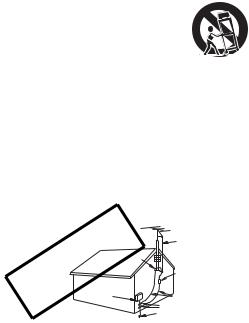
21Placing or Moving — Do not place on an unstable cart, stand, tripod, bracket or table. The product may fall, causing serious injury to a child
or adult, and serious damage to the product.
A product and cart combination should be moved with care. Quick stops, excessive force, and uneven surfaces may cause the product and cart combination to overturn.
22Power Sources — The CA-570 Compact Power Adapter should be
operated only from the type of power source indicated on the marking label. If you are not sure of the type of power supply to your home, consult your product dealer or local power company. Regarding other power sources such as battery power, refer to instructions in this manual.
23Polarization — The CA-570 Compact Power Adapter is equipped with a polarized 2-prong plug (a plug having one blade wider than the other). The 2-prong polarized plug will fit into the power outlet only one way. This is a safety feature. If you are unable to insert the plug fully into the outlet, try reversing the plug. If the plug still fails to fit, contact your electrician to replace your obsolete outlet. Do not defeat the safety purpose of the polarized plug.
24Power Cord Protection — Power cords should be routed so that they are not likely to be walked on or pinched by items placed upon or against them. Pay particular attention to plugs and the point from which the cords exit the product.
25 Outdoor Antenna Grounding — If |
Fig. 1 |
|
an outside antenna is connected to |
||
|
||
the product, be sure the antenna is |
|
|
grounded so as to provide some |
|
|
protection against voltage surges |
|
|
and built-up static charges. Section |
|
|
810 of the National Electrical Code, |
GROUND |
|
ANSI / NFPA No. 70—1984, |
CLAMP |
|
provides information with respect |
|
|
to proper grounding of the mast |
ELECTRIC |
|
and supporting structure, |
SERVICE |
|
EQUIPMENT |
||
grounding of the lead-in wire to an |
||
|
||
antenna discharge unit, size of |
|
|
grounding conductors, locationCOPYof NEC - NATIONAL |
||
antenna discharge unit, connection |
ELECTRICAL CODE |
|
to grounding electrodes, and
requirements for the grounding electrode. See figure 1.
ANTENNA LEAD
IN WIRE
ANTENNA DISCHARGE UNIT (NEC SECTION 810-20)
GROUNDING CONDUCTORS (NEC SECTION 810-21)
GROUND CLAMPS
POWER SERVICE GROUNDING ELECTRODE SYSTEM
(NEC ART 250. PART H)
26Lightning — For added protection of this product during a lightning storm, or when it is left unattended and unused for long periods of time, disconnect it from the wall outlet and disconnect the antenna. This will prevent damage to the product due to lightning and power-line surges.
27Overloading — Do not overload wall outlets and extension cords as this can result in a risk of fire or electric shock.
28Objects and Liquid Entry — Never push objects of any kind into this product through openings as they may touch dangerous voltage points or short out parts that could result in a fire or electric shock. Be careful not to spill liquid of any kind onto the product.
29Servicing — Do not attempt to service this product yourself as opening or removing covers may expose you to dangerous voltage or other hazards. Refer all servicing to qualified service personnel.
5

30Damage Requiring Service — Disconnect this product from the wall outlet and all power sources including battery, and refer servicing to qualified service personnel under the following conditions:
a.When the power-supply cord or plug is damaged.
b.If any liquid has been spilled onto, or objects have fallen into, the product.
c.If the product has been exposed to rain or water.
d.If the product does not operate normally even if you follow the operating instructions. Adjust only those controls that are covered by the operation instructions. Improper adjustment of other controls may result in damage and will often require extensive work by a qualified technician to restore the product to its normal operation.
e.If the product has been dropped or the cabinet has been damaged.
f.When the product exhibits a distinct change in performance. This indicates a need for service.
31Replacement Parts — When replacement parts are required, be sure the service technician has used replacement parts that are specified by Canon or that have the same characteristics as the original part. Unauthorized substitutions may result in fire, electric shock or other hazards.
32Safety Check — Upon completion of any service or repairs to this product, ask the service technician to perform safety checks to determine that the product is in safe operating order.
33Heat — The product should be situated away from heat sources such as radiators, heat registers, stoves, or other products (including amplifiers) that produce heat.
When replacement of the powerCOPYsupply is required, please return it to the responsible nearest Canon Service Center and please replace it with the same type number CA-570.
CA-570 identification plate is located on the bottom.
The Adapter can be used with a power supply between 100 and 240 V AC. For areas where 120 V AC power is not used, you will need a special plug adapter. Contact your nearest Canon Service Center for further information.
This Class B digital apparatus complies with Canadian ICES-003.
6
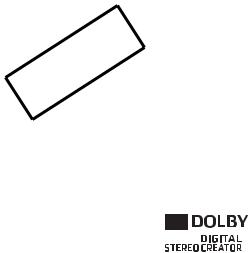
COPY
Trademark Acknowledgements
•SD, SDHC and SDXC Logos are trademarks of SD-3C, LLC.
•Microsoft and Windows are trademarks or registered trademarks of Microsoft Corporation in the United States and/or other countries.
•Macintosh and Mac OS are trademarks of Apple Inc., registered in the U.S. and other countries.
•Manufactured under license from Dolby Laboratories.
“Dolby” and the double-D symbol are trademarks of Dolby Laboratories.
•Other names and products not mentioned above may be trademarks or registered trademarks of their respective companies.
•This device incorporates exFAT technology licensed from Microsoft.
•ANY USE OF THIS PRODUCT OTHER THAN CONSUMER PERSONAL USE IN
ANY MANNER THAT COMPLIES WITH THE MPEG-2 STANDARD FOR ENCODING VIDEO INFORMATION FOR PACKAGED MEDIA IS EXPRESSLY PROHIBITED WITHOUT A LICENSE UNDER APPLICABLE PATENTS IN THE MPEG-2 PATENT PORTFOLIO, WHICH LICENSE IS AVAILABLE FROM MPEG LA, L.L.C., 250 STEELE STREET, SUITE 300, DENVER, COLORADO 80206.
7

Exciting Features
Whether you are using a camcorder for the first time or are very experienced, this camcorder offers many easy-to-use functions. The following are just but a few examples of the many functions that can enrich your shooting experience.
 Dual Flash Memory
Dual Flash Memory
You can record in the built-in memory or on commercially available memory cards ( 35).
35).
Pre-recording
( 54)
54)
When pre-recording is activated, the camcorder starts recording video continuously into a temporary 3-second memory. When you press the Start/Stop button, the scene recorded will have started 3 seconds before
|
|
|
COPY |
||||
|
|
|
|
|
you started shooting. |
||
Video Snapshot |
|
Image Stabilization |
|||||
( |
|
55) |
|
( |
|
54) |
|
|
|
|
|||||
Shoot or capture short scenes |
|
Dynamic IS compensates for |
|||||
and arrange them into a video |
|
camcorder shake when you |
|||||
clip set to your favorite |
|
|
shoot video while walking. This |
||||
background music. |
|
|
gives you more freedom and |
||||
|
|
|
|
|
mobility when recording movies. |
||
|
|
|
|
|
|
|
|
8
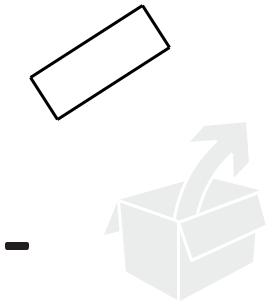
Table of contents
Introduction
8 Exciting Features
12 About this Manual
14Getting to Know the Camcorder
14Supplied Accessories and CD-ROMs
16Names of Parts
Preparations
19Getting Started
19 Charging the Battery Pack
22PreparingCOPYthe Accessories
23Adjusting the Position and Brightness of the LCD Screen27 Using the Menus
30 First Time Settings
30Setting the Date and Time
31Changing the Language
31Changing the Time Zone
32Using a Memory Card
32Memory Cards Compatible for Use with the Camcorder
34Inserting and Removing a Memory Card
35 Selecting the Memory for the Recordings
Selecting the Memory for the Recordings
35Initializing the Memory
Table of contents 9
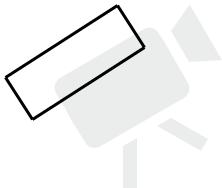
Video
38Basic Recording
38Shooting Video
39Selecting the Video Quality (Recording Mode)
40Zooming: Optical, Advanced and Digital Zoom
41Quick Start Function
43 Basic Playback
43 Playing Back Video
45Selecting what Recordings to Play Back
46Searching for Scenes
48Pre-selecting Recordings from the Index Screen
49Deleting Scenes
51 Advanced Functions
51 Automatic Exposure and Special Scene Recording
Programs
53Automatic Backlight Correction
54Advanced Image Stabilization
54Pre-RecordingCOPY
55Video Snapshot
56Digital Effects
57Manual Exposure Adjustment
58Manual Focus Adjustment
59White Balance
60Image Effects
61Mini Video Light
61Self Timer
62Selecting the Playback Starting Point
63Playing Back Recordings Set to Background Music
66On-Screen Displays and Data Code
67 Playlist and Scene Operations
67 Editing the Playlist: Adding, Deleting and Moving
Scenes
69Dividing Scenes
70 Copying Scenes to a Memory Card
Copying Scenes to a Memory Card
10 Table of contents

Photos
73Taking Photos
74Viewing Photos
76 |
Slideshow |
76 |
Deleting Photos |
78Copying Photos to a Memory Card
External Connections
80Terminals on the Camcorder
80 Connection Diagrams
82Playback on a TV Screen
83Saving and Sharing Your Recordings
83Saving Recordings on a Computer
85Copying Movies to an External Video Recorder
86Preparing Movies for the Web
Additional InformationCOPY
102 Trouble?
102 |
Troubleshooting |
107 |
List of Messages |
114 Do’s and Don’ts
114 Handling Precautions
118Maintenance/Others
119Using the Camcorder Abroad
120General Information
120Accessories
121Optional Accessories
123Product Codes
124 |
Specifications |
128 |
Index |
Table of contents 11
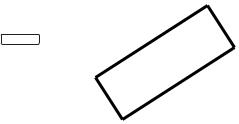
About this Manual
Thank you for purchasing the Canon FS40 / FS400. Please read this manual carefully before you use the camcorder and retain it for future reference. Should your camcorder fail to operate correctly, refer to
Troubleshooting (  102).
102).
Conventions Used in this Manual
• IMPORTANT: Precautions related to the camcorder’s operation.
IMPORTANT: Precautions related to the camcorder’s operation.
• NOTES: Additional topics that complement the basic operating procedures.
NOTES: Additional topics that complement the basic operating procedures.
• POINTS TO CHECK: Restrictions or requirements regarding the function described.
POINTS TO CHECK: Restrictions or requirements regarding the function described.
• : Reference page number within this manual.
: Reference page number within this manual.
• : Text that applies only to the model shown in the icon.
: Text that applies only to the model shown in the icon.
•The following terms are used in this manual:
When not specified as “memory card” or “built-in memory”, the term “memory” by itself refers to both.
“Scene” refers to one movie unit from the point you press the
•The photos included inCOPYthis manual are simulated pictures taken with a still camera. Unless indicated otherwise, illustrations and menu icons refer to the  . pause
. pause
12 Introduction

Brackets [ ] are used to refer to  menu options as they are
menu options as they are 

















displayed on screen.
The names of most buttons and  switches are indicated within a “button” frame.
switches are indicated within a “button” frame.
For example FUNC. .
The  arrow is used to abbreviate menu selections. For a detailed explanation on how to use the menus, refer to Using the Menus
arrow is used to abbreviate menu selections. For a detailed explanation on how to use the menus, refer to Using the Menus
(  27). For a concise summary of all available menu options and settings, refer to the appendix Menu Options Lists (
27). For a concise summary of all available menu options and settings, refer to the appendix Menu Options Lists ( 90).
90).
|
COPY |
|||
|
indicates that a function is available in the operating mode indicated and |
|||
|
indicates that the function is not available. For a detailed explanation |
|||
refer to Operating Modes ( |
|
|
25). |
|
|
|
|||
|
|
|
|
|
Introduction 13

Supplied Accessories and CD-ROMs
The following accessories are supplied with the camcorder:
XCA-570 Compact Power Adapter
(incl. power cord)
BP-808 Battery PackW
XIFC-300PCU/S USB Cable
STV-250N Stereo Video CableW
Yellow • Red • White plugs
XQuick Guide
COPYInstallation Guide for IXELA’sW
Software
14 Introduction

The following CD-ROMs and software are supplied with the camcorder:
•PIXELA’s Transfer Utility CD-ROM*
-Use Transfer Utility for saving and transferring movies and music files you can use as background music.
•PIXELA’s VideoBrowser CD-ROM*
-In addition to all the functionality of Transfer Utility, you can use VideoBrowser for managing, editing, and playing back movies.
• Instruction Manual/Music Data CD-ROM (referred to in this manual as “Camcorder Supplemental Disc”)
Instruction Manual/Music Data CD-ROM (referred to in this manual as “Camcorder Supplemental Disc”)
-Instruction Manual - The full-version instruction manual of the camcorder (this PDF file).
-Music data - Music files that can be used as background music during playback. These music files are for exclusive use with the supplied PIXELA’s software. The disc cannot be played back on CD players.
* The CD-ROM includes the instruction manual of the software (on PDF file).
COPY
Introduction 15
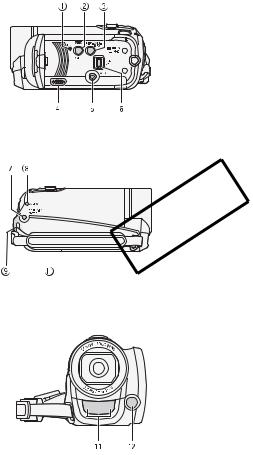
Names of Parts
Left side view
Right side view
1 RESET button ( 106)
106)
2  button (
button ( 25)/ WEB button (
25)/ WEB button (  86)
86)
3DISP. (on-screen display) button
(  62, 66)/BATT. INFO button (
62, 66)/BATT. INFO button ( 101)
101)
4 Speaker ( 43)
43)
5 AV OUT terminal (  80, 81) 6 USB terminal (
80, 81) 6 USB terminal (  80, 81)
80, 81)
7 DC IN terminal ( 19)
19)
8 ACCESS indicator (  38, 73) 9 Strap mount (
38, 73) 9 Strap mount (  22)
22)
qA Grip belt (  22) aA Stereo microphone
22) aA Stereo microphone
sA Mini video light ( 61)
61)



 COPY
COPY
Front view
16 Introduction
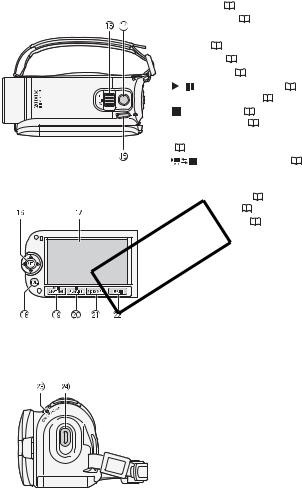
Top view
LCD panel
dA Zoom lever ( |
40) |
|
|
|
fA PHOTO button ( |
|
73) |
|
|
gA POWER button |
|
|
|
|
hA Joystick ( 27) |
|
|
||
jA LCD screen ( |
23) |
|
|
|
kA FUNC. button ( |
28, 90) |
|
||
lA |
/ (play/pause) button ( |
43)/ |
||
START/STOP button ( 38) |
|
|||
qS |
(stop) button ( |
43)/ |
|
|
PLAYLIST button ( |
46) |
|
||
aS VIDEO SNAP (video snapshot) button |
||||
( |
55) |
|
|
|
sS |
(camera/play) button ( |
26) |
||
dS ON/OFF (CHG) (charge) indicator: |
||||
Green – On |
|
|
|
|
Orange – Standby ( |
41) |
|
||
Red – Charging ( |
19) |
|
||
Sf Start/Stop button ( |
38) |
|
||
COPY |
|
|
|
|
Back view
Introduction 17

Bottom view |
Sg Battery release latch |
|
|
|
|
|
Sh Tripod socket ( 114) |
|
|
Sj Memory card slot ( |
34) |
|
Sk Battery compartment ( |
19) |
lS Battery compartment cover/Memory card slot cover
Dq Serial number
The serial number label is located on the battery compartment cover.
COPY
18 Introduction
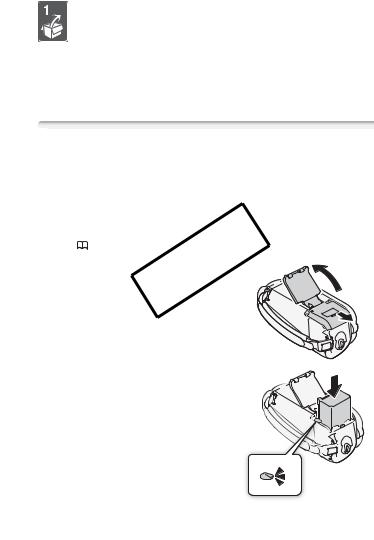
Preparations
This chapter describes basic operations, such as navigating the menus, and first time settings to help you learn more about your camcorder.
Getting Started
Charging the Battery Pack
The camcorder can be powered with a battery pack or directly using the compact power adapter. The first time you use a battery pack, fully charge it and then use the camcorder until the battery pack is completely exhausted. Doing so will ensure that the remaining recording time will be displayed accurately.
For approximate charging times and recording/playback times with a
fully charged battery pack, refer to Charging, Recording and Playback |
||
Times ( 122). |
|
|
1 Slide the battery compartment |
1 |
|
cover away from the lens and open |
||
|
||
it. |
|
|
2 Insert the battery COPYpack all the way into the compartment and press
gently until it clicks.
2
Preparations 19
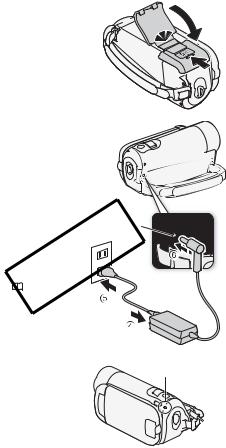
3 Close the cover and slide it toward
|
the lens until you hear a click. |
3 |
|
|
|
4 |
Connect the power cord to the |
|
|
compact power adapter. |
|
5 |
Plug the compact power adapter |
|
|
into a power outlet. |
|
6 |
Connect the compact power |
|
|
adapter to the camcorder’s DC IN |
|
|
terminal. |
|
7 |
Charging will start when the |
|
|
camcorder is turned off. |
|
|
• If the camcorder was on, the green |
|
|
ON/OFF (CHG) indicator will go out |
|
|
when you turn off the camcorder. |
|
|
After a moment, the ON/OFF (CHG) |
|
|
indicator will start flashing in red |
|
|
(battery pack charging). The red |
DC IN |
|
COPY |
|
ON/OFF (CHG) indicator will go out |
terminal |
|
|
when the battery pack is fully |
|
charged. |
|
• If the indicator flashes quickly, refer |
|
to Troubleshooting ( 102). |
|
|
ON/OFF (CHG) |
|
(charge) indicator |
20 Preparations

To remove the battery pack
1 Slide the battery compartment cover away from the lens and open it.
2 Press the battery release latch and pull out the battery pack.
3 Close the cover and slide it toward the lens until you hear a click.
Battery release latch
 IMPORTANT
IMPORTANT
•Turn off the camcorder before connecting or disconnecting the compact power adapter. After pressing POWER to turn off the camcorder,
important data is updated in the memory. Be sure to wait until the green ON/OFF (CHG)COPYindicator goes out.
•We recommend charging the battery pack in temperatures between 10 °C and 30 °C (50 °F and 86 °F). Outside the temperature range of 0 °C to 40 °C (32 °F to 104 °F), charging will not start.
•Do not connect to the camcorder’s DC IN terminal or to the compact power adapter any electrical equipment that is not expressly recommended for use with this camcorder.
•To prevent equipment breakdowns and excessive heating, do not connect the supplied compact power adapter to voltage converters for overseas travels or special power sources such as those on aircraft and ships, DC-AC inverters, etc.
 NOTES
NOTES
•The battery pack will be charged only when the camcorder is off.
•If remaining battery time is an issue, you can power the camcorder using the compact power adapter so the battery pack will not be consumed.
•Charged battery packs continue to discharge naturally. Therefore, charge them on the day of use, or the day before, to ensure a full charge.
Preparations 21
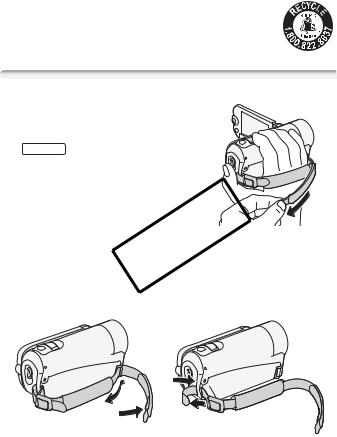
•We recommend that you prepare battery packs to last 2 to 3 times longer than you think you might need.
• USA and Canada only: The Lithium ion/polymer battery that powers the product is recyclable. Please call 1-800-8-BATTERY for information on how to recycle this battery.
Preparing the Accessories
Fasten the grip belt.
Adjust the grip belt so that you can reach the zoom lever with your index finger, and the Start/Stop button with your thumb.
1 |
Lift the padded handgrip’s flap and detach the strap from the Velcro |
|
pad. Pull the strap to remove it from the camcorder’s front bracket. |
2 |
COPY |
Pull the other end of the strap through the buckle and remove it |
from the camcorder’s rear bracket.
22 Preparations

To attach an optional wrist strap
Pass the attaching end of the wrist strap through the rear bracket on the camcorder, thread the wrist strap through the loop and fasten.
Adjusting the Position and Brightness of the LCD Screen
Rotating the LCD Panel
Open the LCD panel 90 degrees.
•You can rotate the panel 90 degrees downward.
•You can rotate the panel 180 degrees toward the lens. Rotating the
LCD panel 180 degrees can be useful when you wish to include yourself in the picture whenCOPYrecording with the self timer.
90° |
Subject can monitor the LCD screen |
 NOTES
NOTES
•About the LCD screen: The screen is produced using extremely high-pre- cision manufacturing techniques, with more than 99.99% of the pixels operating to specification. Less than 0.01% of the pixels may occasionally misfire or appear as black, red, blue or green dots. This has no effect on the recorded image and does not constitute a malfunction.
Preparations 23
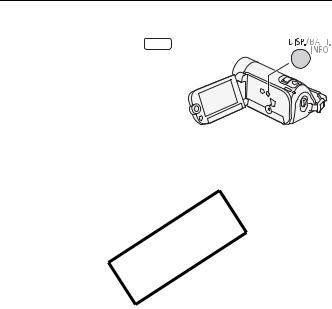
LCD Backlight
When recording in bright places it may be difficult to use the LCD screen. Turn on the LCD backlight to make it brighter.
With the camcorder on, hold DISP. pressed down for more than
2 seconds.
Repeat this action to switch the LCD backlight between off (normal) and on (bright).
 NOTES
NOTES
•The LCD backlight does not affect the brightness of the recordings.
•Using the bright setting will shorten the effective usage time of the battery pack.
•You can further adjust the brightness of the LCD screen with the 
 [LCD Brightness] setting.
[LCD Brightness] setting.
COPY
24 Preparations

Basic Operation of the Camcorder
Operating Modes
Recording
The camcorder offers two basic modes for recording video
and photos: |
|
mode, for beginners or if you just prefer |
|||
not to bother with detailed camcorder settings, and flexible |
|||||
recording ( |
|
) mode, which lets you change the cam- |
|||
corder’s settings to your preference. Press the |
button to |
||||
switch the camcorder to |
mode and press the button |
||||
again to switch back to |
mode. In either mode, you can record |
||||
movies by pressing Start/Stop |
or take photos by pressing PHOTO . |
||||
|
|
|
|
|
|
|
Operating |
|
Onscreen |
Operation |
|
|
mode |
|
icon |
||
|
|
|
|
||
|
|
|
|
|
|
|
|
|
|
Easy recording of movies and photos. |
|
|
|
|
|
|
|
|
|
|
|
Recording of movies and photos while enjoying full |
|
|
|
|
|
access to the menus and advanced functions. |
|
|
About |
|
mode COPY |
|
|
|
|
|
|||
•Only the following buttons/functions are available in this mode.
-Start/Stop for recording movies
-PHOTO for recording photos
- Zoom ( 40)
40)
- Quick Start ( 41)
41)
-  for recording video snapshot scenes (
for recording video snapshot scenes ( 55)
55)
 NOTES
NOTES
• In  mode, menus cannot be accessed but the following settings can be changed in advance.
mode, menus cannot be accessed but the following settings can be changed in advance.
- FUNC. menu: Recording mode of movies.
Preparations 25

- menu: [Rec Media for Movies]*, [Rec Media for Photos]*, [Widescreen], [Video Snapshot Length].
menu: [Rec Media for Movies]*, [Rec Media for Photos]*, [Widescreen], [Video Snapshot Length].
- menu: [Image Stabilizer]**, [Auto Slow Shutter].
menu: [Image Stabilizer]**, [Auto Slow Shutter].
- ,
,  and
and  menus: All settings.
menus: All settings.
*  only.
only.
**The [  Standard] setting will be used in
Standard] setting will be used in  mode if set to [
mode if set to [  Off] in
Off] in
 mode.
mode.
•Even in  mode, the camcorder can help you with the settings. For example, you can use the Special Scene recording programs (
mode, the camcorder can help you with the settings. For example, you can use the Special Scene recording programs (  51) to set at once all the optimal settings to match special recording conditions.
51) to set at once all the optimal settings to match special recording conditions.
Playback
Press the  (camera/play) button to switch the camcorder between camera (recording) mode and playback mode. You can press
(camera/play) button to switch the camcorder between camera (recording) mode and playback mode. You can press  when the camcorder is off to turn it on directly in playback mode.
when the camcorder is off to turn it on directly in playback mode.
Operating mode |
COPY |
Operation |
|
Onscreen icon |
|
||
|
|
laying back movies. |
|
|
|
Viewing photos. |
|
 NOTES
NOTES
• When switching to playback mode, the [Movies] index screen will be
selected ( |
mode). Use the tabs on the top of the screen to switch |
|||
to |
mode to view photos ( |
|
45). |
|
|
||||
• |
When switching to playback mode, the memory selected for |
|||
playback will be the same currently used for recording movies.
26 Preparations

Joystick and Joystick Guide
Use the joystick to operate the camcorder’s menus.
Push the joystick up, down, left or right ( ,
,  ) to select an item or change settings.
) to select an item or change settings.
Press the joystick itself ( 
 ) to save
) to save  the settings or confirm an action. On
the settings or confirm an action. On  menu screens, this is indicated by the
menu screens, this is indicated by the
icon  .
.
The functions that appear in the joystick guide depend on the operating mode. By default, the joystick guide is minimized. Push the joy-
stick ( ) to display it. |
|
|
|
|
||
• |
or |
mode: Select ( |
) a function and press |
to change |
||
|
the setting. With some functions, you will need to make further |
|
||||
|
adjustments ( |
). |
|
|
|
|
• |
mode: First, select ( |
) a “row” of functions; then, press |
to |
|||
|
operate the function in the middle or push the joystick ( |
or |
) to |
|||
|
operate the function on the left or right, respectively. |
|
|
|||
|
|
COPY |
|
|
||
The joystick guide will minimize after 2 seconds. When the joystick |
||||||
guide is minimized, you can still adjust or turn on/off the selected |
||||||
function; you can also maximize ( |
) the joystick guide to select |
|
||||
another function, or hide ( |
) it altogether. |
|
|
|||
Using the Menus |
|
|
|
|
||
Many of the camcorder’s functions can |
|
|
||||
be adjusted from the menus that open |
|
|
||||
after pressing FUNC. . In |
mode, |
|
|
|||
however, menus cannot be accessed and, except in a few cases, most menu settings will return to their default val-
ues.
For details about the available menu options and settings, refer to the appendix Menu Options Lists ( 90).
90).
Preparations 27

Selecting an Option from the FUNC. Menu
The following is an example of selecting a FUNC. menu option in  mode. In playback modes, the operation varies depending on the function selected so refer to the relevant chapter as necessary.
mode. In playback modes, the operation varies depending on the function selected so refer to the relevant chapter as necessary.
1 Press FUNC. .
2 Select ( ) the icon of the function you want to change from the left side column.
) the icon of the function you want to change from the left side column.
Menu items not available will appear grayed out.
3Select ( ) the desired setting from the available options at the bottom bar.
) the desired setting from the available options at the bottom bar.
•The selected option will be highlighted in orange.
•With some settings you will need to make further selections and/or
press  . Follow the additional operation guides that will appear on the screen (such as the
. Follow the additional operation guides that will appear on the screen (such as the  icon, small arrows, etc.).
icon, small arrows, etc.).
4Press FUNC. to saveCOPYthe settings and close the menu.
You can press FUNC. to close the menu at any time.
to open the setup menus.
You can also hold FUNC. pressed down for more than 1 second to open directly the setup menus screen.
3 Select ( ) the tab of the desired menu.
) the tab of the desired menu.
4 Select ( ) the setting you want to change and press
) the setting you want to change and press  .
.
•The orange selection bar indicates the menu setting currently selected. Menu items not available appear grayed out.
•Move ( ) the orange selection bar to the tabs at the top of the screen to select a different menu (step 3).
) the orange selection bar to the tabs at the top of the screen to select a different menu (step 3).
5Select ( ,
,  ) the desired option and press
) the desired option and press  to save the setting.
to save the setting.
28 Preparations
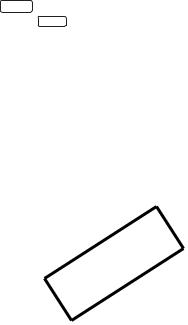
6Press FUNC. .
You can press FUNC. to close the menu at any time.
COPY
Preparations 29

First Time Settings
Setting the Date and Time
You will need to set the date and time of the camcorder before you can start using it. The [Date/Time] screen will appear automatically when the camcorder’s clock is not set.
When the [Date/Time] screen appears, the year will be selected.
1 Change ( ) the year and move (
) the year and move ( ) to the month.
) to the month.
2Change the rest of the fields (month, day, hour and minutes) in the same way.
3Select ( ) [OK] and press
) [OK] and press  to start the clock and close the setup screen.
to start the clock and close the setup screen.
 NOTES
NOTES
•When you do not use the camcorder for about 3 months, the built-in rechargeable lithium battery may discharge completely and the date and time setting may be lost. In such case, recharge the built-in lithium battery ( 117) and set the time zone, date and time again.
•The date appears in a year-month-day format only in the first setup screen. In subsequent screen displays the date and time will appear as month-day-year (for example, [Jan. 1, 2011 12:00 AM]). You can change the date format and the clock format (12/24 hours) with the 
 [Date Format] setting.
[Date Format] setting.
•You can also change the date and time later on (not during the initial setup). Open the [Date/Time] screen from the setup menus:COPY
FUNC.  [
[  Menu]
Menu] 

 [Date/Time]
[Date/Time]
30 Preparations
